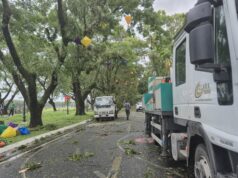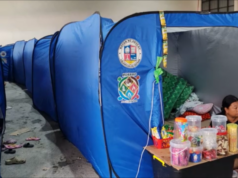CITY OF SAN FERNANDO – Amid threat of a rainy La Niña phenomenon, studies have revealed that 43 barangays in Pampanga and Nueva Ecija are prone to liquefaction, a geological phenomenon in which solid ground turns into virtual liquid during an earthquake.
The barangays were among those identified by the regional office of the Mines and Geo-Sciences Bureau (MGB) which is now preparing hazard maps based on a “rapid geological assessments” it has been conducting for years now starting 2006 in various barangays in Central Luzon.
MBG regional geologist Orlando Pineda Sr. said that so far, hazard maps for Pampanga, Zambales and Aurora have been finished in coordination with the National Mapping and Resource Information Authority, the Philippine Institute of Volcanology and Seismology, and the Philippine Atmospheric, Geological and Astronomical Services Administration.
Pineda allowed Punto Central Luzon access to the geological study documents which are to be the basis of all the provincial hazard maps for use of provincial and other local disaster coordinating councils in disaster management and emergency planning.
The documents pertained to five provinces in the region, except Tarlac.
The documents indicated that all 23 barangays of coastal Sasmuan town are prone to liquefaction. The other areas similarly at risk from the unusual phenomenon are Barangays Batasan, Candelaria, Consuelo, San Esteban and San Francisco in Macabebe and Barangays Bulac, Sta. Catalina, Daue, San Francisco I, San Francisco 2, Manica, Sta. Rita, San Pedro and Saplad in Minalin, all in Pampanga.
In Laur, Nueva Ecija, barangays Panaulo and Betania, as well as a sitio called Pangarolong are also prone to liquefaction.
Liquefaction occurs when liquid-saturated ground is shook by an earthquake. It is also often referred to as earthquake liquefaction.
Last Tuesday the UN weather agency said that El Niño, which wreaks havoc around the Pacific and east Africa, has dissipated. But La Niña – another disruptive weather phenomenon, is likely to develop.
“Following the rapid dissipation of El Niño in early May 2010, cool-neutral to weak La Niña conditions have developed in the tropical Pacific,” said the World Meteorological Organization in a statement.
The MGB report in Central Luzon identified at least 192 barangays threatened by “high flooding” in the region. More areas, however, were classified as under threat from low or moderate flooding.
The study explained that “high flooding” referred to floodwaters at least a meter deep. Moderate floods are at least 0.51 to one meter deep, while low floods are lower than 0.51 meter.
It cited lack of drainage as well as proximity to creeks or rivers as the most common reasons for high level flooding.
It also identified 23 barangays, mostly in Bulacan, Nueva Ecija and Aurora which are at “high” risk from landslide.
In Pampanga, areas under high risk from floods include 16 barangays in Macabebe, 12 in Masantol, 11 in Guagua, 10 in MInalin, nine each in Bacolor and Lubao, seven in Apalit, six in San Fernando, five each in San Simon and Sto. Tomas, and one in Mexico.
In Bulacan, the high risk areas are 14 barangays in Hagonoy, nine each in Obando and Calumpit, four in Marilao, three in Balagtas, and one in Bulakan.
The high risk flood areas in Nueva Ecija include 12 barangays in Zaragoza, eight in Guimba, four in Sta. Rosa, three each in San Leonardo, Gen. Tinio, Bongabon, and Quezon, two in Carangglan, and one each in Licab and Gapan City.
Those in danger of floods at least a meter deep in Bataan include five barangays in Hermosa, four in Dinalupihan, two in Orani, and one in Mariveles.
In Aurora province, at risk from severe floods are two barangays each in Ma. Aurora and Casiguran and one each in Baler and San Luis.
The study also named barangays under high risk from landslide, including six barangays in Carangglan, one in Rizal, three in Gabaldon, all in Nueva Ecija; one each in Norzagaray and San Jose del Monte in Bulacan, and; five barangays in Dingalan, four in Dilasag and two in Casiguran, all in Aurora.
The barangays were among those identified by the regional office of the Mines and Geo-Sciences Bureau (MGB) which is now preparing hazard maps based on a “rapid geological assessments” it has been conducting for years now starting 2006 in various barangays in Central Luzon.
MBG regional geologist Orlando Pineda Sr. said that so far, hazard maps for Pampanga, Zambales and Aurora have been finished in coordination with the National Mapping and Resource Information Authority, the Philippine Institute of Volcanology and Seismology, and the Philippine Atmospheric, Geological and Astronomical Services Administration.
Pineda allowed Punto Central Luzon access to the geological study documents which are to be the basis of all the provincial hazard maps for use of provincial and other local disaster coordinating councils in disaster management and emergency planning.
The documents pertained to five provinces in the region, except Tarlac.
The documents indicated that all 23 barangays of coastal Sasmuan town are prone to liquefaction. The other areas similarly at risk from the unusual phenomenon are Barangays Batasan, Candelaria, Consuelo, San Esteban and San Francisco in Macabebe and Barangays Bulac, Sta. Catalina, Daue, San Francisco I, San Francisco 2, Manica, Sta. Rita, San Pedro and Saplad in Minalin, all in Pampanga.
In Laur, Nueva Ecija, barangays Panaulo and Betania, as well as a sitio called Pangarolong are also prone to liquefaction.
Liquefaction occurs when liquid-saturated ground is shook by an earthquake. It is also often referred to as earthquake liquefaction.
Last Tuesday the UN weather agency said that El Niño, which wreaks havoc around the Pacific and east Africa, has dissipated. But La Niña – another disruptive weather phenomenon, is likely to develop.
“Following the rapid dissipation of El Niño in early May 2010, cool-neutral to weak La Niña conditions have developed in the tropical Pacific,” said the World Meteorological Organization in a statement.
The MGB report in Central Luzon identified at least 192 barangays threatened by “high flooding” in the region. More areas, however, were classified as under threat from low or moderate flooding.
The study explained that “high flooding” referred to floodwaters at least a meter deep. Moderate floods are at least 0.51 to one meter deep, while low floods are lower than 0.51 meter.
It cited lack of drainage as well as proximity to creeks or rivers as the most common reasons for high level flooding.
It also identified 23 barangays, mostly in Bulacan, Nueva Ecija and Aurora which are at “high” risk from landslide.
In Pampanga, areas under high risk from floods include 16 barangays in Macabebe, 12 in Masantol, 11 in Guagua, 10 in MInalin, nine each in Bacolor and Lubao, seven in Apalit, six in San Fernando, five each in San Simon and Sto. Tomas, and one in Mexico.
In Bulacan, the high risk areas are 14 barangays in Hagonoy, nine each in Obando and Calumpit, four in Marilao, three in Balagtas, and one in Bulakan.
The high risk flood areas in Nueva Ecija include 12 barangays in Zaragoza, eight in Guimba, four in Sta. Rosa, three each in San Leonardo, Gen. Tinio, Bongabon, and Quezon, two in Carangglan, and one each in Licab and Gapan City.
Those in danger of floods at least a meter deep in Bataan include five barangays in Hermosa, four in Dinalupihan, two in Orani, and one in Mariveles.
In Aurora province, at risk from severe floods are two barangays each in Ma. Aurora and Casiguran and one each in Baler and San Luis.
The study also named barangays under high risk from landslide, including six barangays in Carangglan, one in Rizal, three in Gabaldon, all in Nueva Ecija; one each in Norzagaray and San Jose del Monte in Bulacan, and; five barangays in Dingalan, four in Dilasag and two in Casiguran, all in Aurora.




